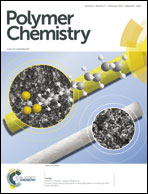(Meth)acrylic monomers with heteroatom-containing ester side chains: a systematic PLP-SEC and polymerization study†
Abstract
The Arrhenius parameters of the propagation rate coefficient for two hetero-atom containing (meth)-acrylates (studied as 1 M solution in N,N-dimethylacetamide (DMAc)) are determined via the pulsed laser polymerization – size-exclusion chromatography (PLP-SEC) method. Absolute molar mass determination is achieved via SEC coupled to on-line multi-angle laser light scattering (MALLS). The data obtained for hydroxypropylcarbamate acrylate (HPCA, A = 3.97 (−1.44 to 1.63) × 106 L mol−1 s−1 and Ea = 14.3 (−1.38 to 5.13) kJ mol−1) are critically compared with the literature known data sets of two structural derivatives, i.e., 2-(phenylcarbamoyloxy)isopropyl acrylate (PhCPA) and 2-(hexylcarbamoyloxy)isopropyl acrylate (HCPA), indicating an increase in the propagation rate coefficient with increasing ester side chain length. Ureidoethyl methacrylate (UMA, A = 2.08 (−0.45 to 0.91) × 106 L mol−1 s−1 and Ea = 19.9 (−0.89 to 0.91) kJ mol−1) represents the first hetero-atom containing methacrylate to be studied via PLP-SEC, evidencing a significantly higher propagation rate coefficient compared to earlier investigated methacrylate-type monomers. Furthermore, the free-radical polymerization behavior of HPCA and UMA is studied via in situ1H-NMR experiments at elevated temperatures allowing for an estimation of average termination rate coefficients (at low conversion) in conjunction with the determined kp data. Furthermore, the polymerization of UMA was successfully controlled by reversible addition–fragmentation chain transfer (RAFT) polymerization as evidenced by the linear evolution of the number-average molar mass, Mn, with conversion (3000 g mol−1 ≤ Mn ≤ 23 000 g mol−1, 1.15 ≤ Đ ≤ 1.3) as well as by nitroxide-mediated polymerization (NMP), as demonstrated by the linear evolution of Mn with conversion (4000 g mol−1 ≤ Mn ≤ 40 000 g mol−1, 1.3 ≤ Đ ≤ 1.4). In addition, HPCA polymerization was successfully controlled by the RAFT process, as evidenced by the linear evolution of Mn with conversion (2000 g mol−1 ≤ Mn ≤ 21 000 g mol−1, 1.2 ≤ Đ ≤ 1.4) and successful chain extension experiments. Finally, the NMP of HPCA exhibited uniform shifts of the molar mass distributions in the range of 5000 g mol−1 ≤ Mn ≤ 70 000 g mol−1 and successful chain extension experiments.


 Please wait while we load your content...
Please wait while we load your content...